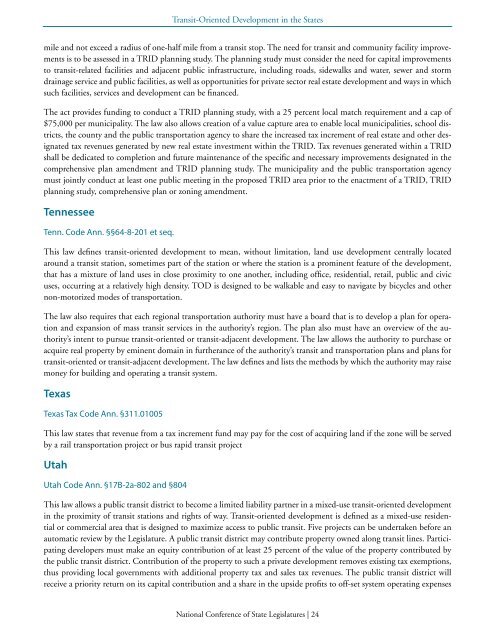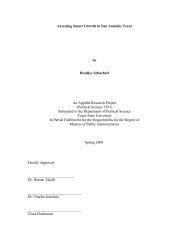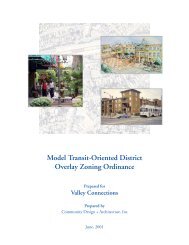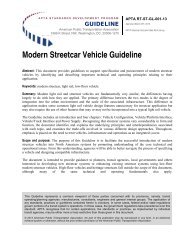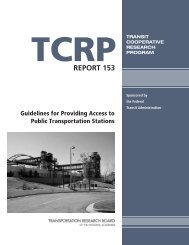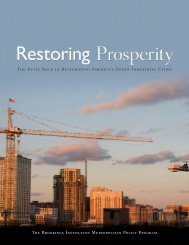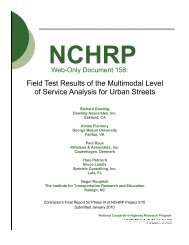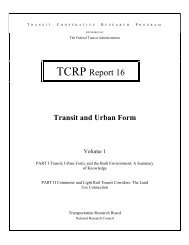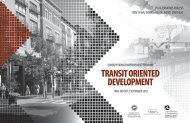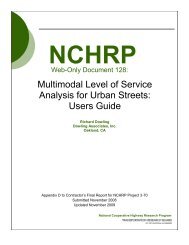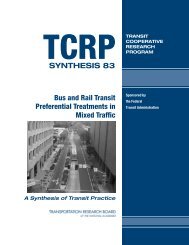Download the full report (PDF, 734 KB) - Reconnecting America
Download the full report (PDF, 734 KB) - Reconnecting America
Download the full report (PDF, 734 KB) - Reconnecting America
- No tags were found...
You also want an ePaper? Increase the reach of your titles
YUMPU automatically turns print PDFs into web optimized ePapers that Google loves.
Transit-Oriented Development in <strong>the</strong> Statesmile and not exceed a radius of one-half mile from a transit stop. The need for transit and community facility improvementsis to be assessed in a TRID planning study. The planning study must consider <strong>the</strong> need for capital improvementsto transit-related facilities and adjacent public infrastructure, including roads, sidewalks and water, sewer and stormdrainage service and public facilities, as well as opportunities for private sector real estate development and ways in whichsuch facilities, services and development can be financed.The act provides funding to conduct a TRID planning study, with a 25 percent local match requirement and a cap of$75,000 per municipality. The law also allows creation of a value capture area to enable local municipalities, school districts,<strong>the</strong> county and <strong>the</strong> public transportation agency to share <strong>the</strong> increased tax increment of real estate and o<strong>the</strong>r designatedtax revenues generated by new real estate investment within <strong>the</strong> TRID. Tax revenues generated within a TRIDshall be dedicated to completion and future maintenance of <strong>the</strong> specific and necessary improvements designated in <strong>the</strong>comprehensive plan amendment and TRID planning study. The municipality and <strong>the</strong> public transportation agencymust jointly conduct at least one public meeting in <strong>the</strong> proposed TRID area prior to <strong>the</strong> enactment of a TRID, TRIDplanning study, comprehensive plan or zoning amendment.TennesseeTenn. Code Ann. §§64-8-201 et seq.This law defines transit-oriented development to mean, without limitation, land use development centrally locatedaround a transit station, sometimes part of <strong>the</strong> station or where <strong>the</strong> station is a prominent feature of <strong>the</strong> development,that has a mixture of land uses in close proximity to one ano<strong>the</strong>r, including office, residential, retail, public and civicuses, occurring at a relatively high density. TOD is designed to be walkable and easy to navigate by bicycles and o<strong>the</strong>rnon-motorized modes of transportation.The law also requires that each regional transportation authority must have a board that is to develop a plan for operationand expansion of mass transit services in <strong>the</strong> authority’s region. The plan also must have an overview of <strong>the</strong> authority’sintent to pursue transit-oriented or transit-adjacent development. The law allows <strong>the</strong> authority to purchase oracquire real property by eminent domain in fur<strong>the</strong>rance of <strong>the</strong> authority’s transit and transportation plans and plans fortransit-oriented or transit-adjacent development. The law defines and lists <strong>the</strong> methods by which <strong>the</strong> authority may raisemoney for building and operating a transit system.TexasTexas Tax Code Ann. §311.01005This law states that revenue from a tax increment fund may pay for <strong>the</strong> cost of acquiring land if <strong>the</strong> zone will be servedby a rail transportation project or bus rapid transit projectUtahUtah Code Ann. §17B-2a-802 and §804This law allows a public transit district to become a limited liability partner in a mixed-use transit-oriented developmentin <strong>the</strong> proximity of transit stations and rights of way. Transit-oriented development is defined as a mixed-use residentialor commercial area that is designed to maximize access to public transit. Five projects can be undertaken before anautomatic review by <strong>the</strong> Legislature. A public transit district may contribute property owned along transit lines. Participatingdevelopers must make an equity contribution of at least 25 percent of <strong>the</strong> value of <strong>the</strong> property contributed by<strong>the</strong> public transit district. Contribution of <strong>the</strong> property to such a private development removes existing tax exemptions,thus providing local governments with additional property tax and sales tax revenues. The public transit district willreceive a priority return on its capital contribution and a share in <strong>the</strong> upside profits to off-set system operating expensesNational Conference of State Legislatures | 24


